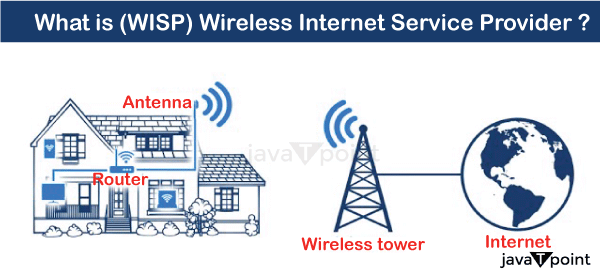Wireless Internet Service Provider (WISP)A Wireless Internet Service Provider (WISP) is an Internet Service Provider (ISP) that offers clients internet access through wireless communication technology, particularly in areas where traditional wired connections such as DSL, cable, or fiber-optic lines are prevalent. WISPs utilize radio frequency (RF) signals to transmit data wirelessly to their network infrastructure and customer premises, enabling internet access in locations where conventional broadband options are limited or unavailable. WISPs regularly offer services, which include location-based totally content material, virtual private networks (VPNs), and voice-over IP. This ISP in a remote network, similar to a big statewide initiative, is largely centered on wi-fi networking. WISP holds a very good-sized market share in rural areas in which cable and digital subscriber strains aren't to be had. 
Working of WISPA Wireless Internet Service Provider (WISP) allows purchasers with internet access to use wireless transmission in the vicinity of traditional connections, such as DSL or cable. Let's examine the main components of a Wireless ISP. Basic Service Sets (BSS): A Basic Service Set contains a number one server and numerous stations (customer premises), which might be wirelessly connected to it. In the case of WISPs, this might be a single mobile tower servicing a particular geographical vicinity. The tower serves because they get access to the elements. Extended Service Set: More sophisticated WISP networks appoint an extended service set (ESS) shape. This is similar to having many cell towers in several locations, which are connected to offer large coverage and smooth handoffs as clients journey among service areas. IEEE 802.11b Specifications: WISPs regularly adopt the IEEE 802.11b standard for wireless communication exchange. This standard specifies the protocols for constructing wireless local area networks (WLAN) within the 2.4 GHz range. Cell towers and backhaul channels: WISPs use cell towers to send and acquire signals to and from clients' devices. These towers are intentionally placed to cover certain geographical areas. Backhaul channels connect separate provider areas or towers, developing a network that allows statistics to be despatched amongst them. This is vital for turning in the internet to get the right access to customers beyond the nearby tower's range. Internet Service Plans: Wireless Internet Service Providers (WISPs) provide a wide range of internet service options tailored to meet the diverse needs of their clients. These plans encompass a variety of download speeds, ranging from standard megabits per second to high-speed gigabit connections. In addition to offering reliable wireless internet, WISPs also extend services such as digital subscriber line (DSL) and both business and residential internet subscriptions. Infrastructure Maintenance: WISPs want to robotically maintain their network infrastructure to ensure normal performance and high levels of dependability. This includes tracking the system, troubleshooting problems, and upgrading hardware or software packages as deemed critical. Capacity feedback is important to ensure that there is enough good bandwidth to serve all customers in a selected area without compromising on speed or offering good quality. Terrestrial Fibre Network Rings: The terrestrial fiber community offers a guide for WISPs. These fiber optic networks provide high-velocity, reliable, and scalable backhaul connections, making sure that records are in a timely fashion transmitted between towers and issuer areas. Fibre optic connections assist in improving internet speeds, community recoverability in the event of a loss, and the general resilience of WISP infrastructure. Advantages of WISPs
Challenges and limitations
Next TopicWireless Backhaul
|
 For Videos Join Our Youtube Channel: Join Now
For Videos Join Our Youtube Channel: Join Now
Feedback
- Send your Feedback to [email protected]
Help Others, Please Share









